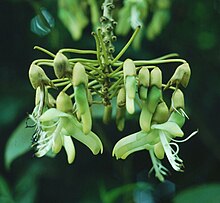Mucuna holtonii is a species of plant in the bean family, which is pollinated by bats. Bats are able to detect if the flowers have nectar using echolocation.[2][3] After an initial bat visit during which nectar is removed, the petals are arranged in a different manner (altering the shape of the flower). As a result, the unique "echo fingerprint" of petal arrangement informs the bat whether nectar is present or absent.
| Mucuna holtonii | |
|---|---|

| |
| Mucuna holtonii, inflorescence | |
| Scientific classification | |
| Kingdom: | Plantae |
| Clade: | Tracheophytes |
| Clade: | Angiosperms |
| Clade: | Eudicots |
| Clade: | Rosids |
| Order: | Fabales |
| Family: | Fabaceae |
| Subfamily: | Faboideae |
| Genus: | Mucuna |
| Species: | M. holtonii
|
| Binomial name | |
| Mucuna holtonii | |
| Synonyms | |
|
Stizolobium holtonii[1] | |
It is thought that the plant evolved acoustically conspicuous structures to make them easier to detect by glossophagine bats.[3]
References
edit- ^ IPNI
- ^ *D. von Helversen and O. von Helversen. "Object recognition by echolocation: a nectar feedingbat exploiting the flowers of a rain forest vine". in Journal of Comp. Physiol. A. (2003) 189: 327-336.
- ^ a b von Helversen & von Helversen (1999) Acoustic guide in bat-pollinated flower Nature 398:759-760.